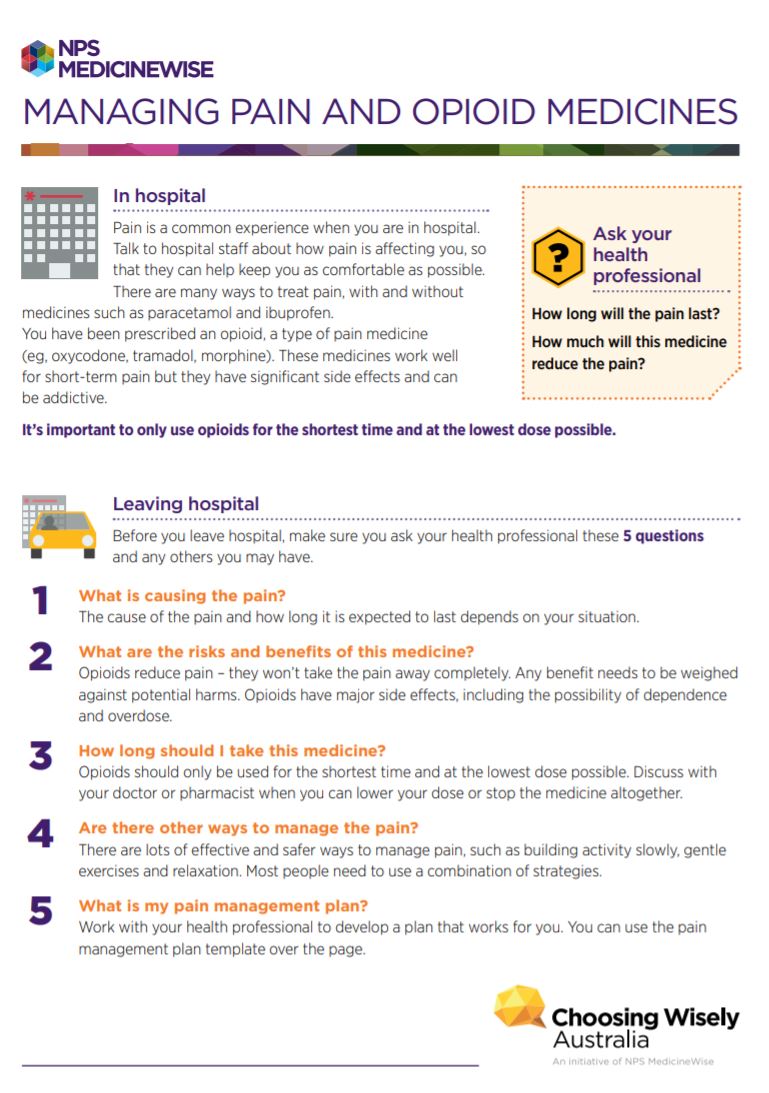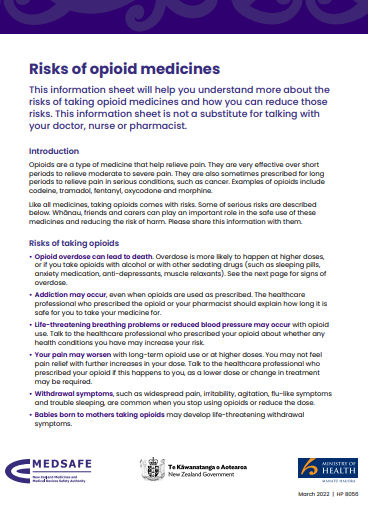Codeine
Sounds like 'KOE-deen'
Key points about codeine
- Codeine is used for moderately severe pain such as after an injury, or operation or for pain caused by a terminal illness such as cancer.
- Follow the instructions on the label of your medicine, for how much to take and how often.
- Find out how to take it safely and possible side effects.

Codeine is used for the relief of moderately severe pain, such as after an injury or operation. It's usually used when milder pain relief such as paracetamol or non-steroidal anti-inflammatories (NSAIDs) don’t work well enough.
- Codeine belongs to a group of medicines called opioids. They act on your brain and nervous system to reduce pain.
- Other pain relievers such as paracetamol and NSAIDs (ibuprofen, diclofenac, naproxen) may also be used with codeine.
- Read more about pain, pain-relief medication and opioid painkillers
Note: Codeine can also be used to treat dry cough and diarrhoea.
In Aotearoa New Zealand codeine is available as tablets in different strengths (15 mg, 30 mg and 60 mg).
- The dose of codeine is different for different people.
- Always take codeine exactly as your doctor has told you.
- Depending on the reason you're taking codeine, your doctor may advise you to take regular doses or take it only when you need it for relief. Make sure you know how you are to take it.
- The pharmacy label on your medicine will tell you how much codeine to take, how often to take it and any special instructions.
- If you’re drowsy or sleepy, don’t take your next dose until you’re wide awake. Ask your healthcare provider for advice.
People may respond differently to codeine
Codeine is broken down in your liver to morphine, which is a strong pain reliever. People may respond differently to codeine depending on how their liver breaks down codeine.
- Some people are 'poor metabolisers' of codeine, which means that they are unable to convert codeine to morphine, and don't get enough pain relief.
- Some other people break down codeine very quickly (ultra-rapid metabolisers) and are at increased risk of developing side effects, even at low doses.
- Estimates suggest that up to 10% of the European/Pākehā population may be poor or ultra-rapid codeine metabolisers. The prevalence in Māori and Pacific Peoples isn't known.
- If you're taking codeine for pain relief, and it doesn’t seem to be working, let your doctor know.
- If you're taking codeine and get side effects such as nausea, vomiting, constipation, lack of appetite, drowsiness or extreme sleepiness, let your doctor know. Other options may be better for you.
- If you have more severe side effects, such as difficulty waking, confusion or shallow breathing, let your doctor know straight away or call Healthline 0800 611 116.
- Follow the instructions on the label of your medicine, for how much to take and how often.
- You can take codeine with or without food.
- If you're taking it regularly and forget to take your dose, take it as soon as you remember that day. But if it's nearly time for your next dose, just take the next dose at the right time. Don't take double the amount.
Here are some things to know when you're taking codeine. Other things may be important as well, so ask your healthcare provider what you should know about.
Eat plenty of fibre and drink more water while you are taking codeine
- Codeine can affect your bowel movements – it might be hard or painful to poo (constipation).
- If this happens, ask your healthcare provider for a laxative, to soften your poo.
- Eating foods with fibre, drinking plenty of water and keeping active can help.
Codeine can make you sleepy, drowsy, dizzy or affect your concentration
- If you’re drowsy or sleepy, don’t take your next dose until you’re wide awake. Ask your healthcare provider for advice.
- Limit or avoid alcohol as it can make these effects worse.
- Don’t drive a vehicle, ride a bike or operate machinery (including power tools) and don’t make important personal or business decisions or sign legal papers if you're feeling sleepy, drowsy or have trouble concentrating.
Taking other medicines
- Your doctor may recommend taking other pain relievers such as paracetamol and NSAIDs (ibuprofen, diclofenac, naproxen) as well. If taken regularly, they can reduce how much codeine you need to take.
- If you're taking any other medicines, or starting a new medicine, check with your doctor or pharmacist to make sure they're safe to take with codeine. This includes any medicines you buy without a prescription (over the counter), such as herbal and complementary medicines or recreational drugs.
Codeine reduces severe pain but won’t take all of your pain away
If your pain isn’t improving don’t take extra doses. Try other ways to manage your pain such as relaxation techniques, gentle exercises and stretches.
Codeine is addictive
- If you're addicted to codeine, you may find it difficult to stop taking it or feel you need to take it more often than necessary.
- It's unusual for people who are prescribed codeine for a short time or for a terminal illness to become addicted to it.
- Some people are more likely to develop addiction than others and seem to be very sensitive to the cravings. You may be at risk for addiction if you have mental health problems, such as depression, or a history of substance abuse, including alcohol and recreational drugs.
- To reduce your risk of addiction when using codeine for short-term pain relief, use it for the shortest possible time, at the lowest effective dose.
- Have a plan in place for how and when to reduce and stop taking it.
- Talk to your doctor if you're worried about addiction or if you want to know more about how to prevent withdrawal symptoms.
Like all medicines, codeine can cause side effects, although not everyone gets them. Often side effects improve as your body gets used to the new medicine.
| Side effects | What should I do? |
|---|---|
|
|
|
|
|
|
|
|
|
|
Read more about medicines and side effects and reporting a reaction you think might be a side effect. |
|
The following links provide further information on codeine:
Codeine Phosphate(external link) Medsafe Consumer Information, NZ
Codeine(external link) New Zealand Formulary Patient Information
Brochures
Managing pain and opioid medicines(external link) NPS MedicineWise & Choosing Wisely Australia
Risks of opioid medicines(external link) Medsafe and Ministry of Health, NZ, 2022
5 questions to ask about your medications(external link) Health Quality and Safety Commission, NZ, 2019 English(external link), te reo Māori(external link)
Opioid medicines for short-term pain [PDF, 105 KB] Healthify He Puna Waiora, NZ, 2023 English [PDF, 105 KB], te reo Māori [PDF, 126 KB]
References
- Codeine(external link) New Zealand Formulary
- Opioid analgesics(external link) New Zealand Formulary
- Codeine – new restrictions on use in children and young adults(external link) Medsafe, NZ, 2018
- Helping patients cope with chronic non-malignant pain: it’s not about opioids(external link) BPAC, NZ, 2014
- Identifying and managing addiction to opioids(external link) BPAC, NZ, 2014
Brochures

NPS MedicineWise & Choosing Wisely Australia

Medsafe and Ministry of Health, NZ, 2022
Credits: Sandra Ponen, Pharmacist, Healthify He Puna Waiora. Healthify is brought to you by Health Navigator Charitable Trust.
Reviewed by: Angela Lambie, Pharmacist, Auckland
Last reviewed:






